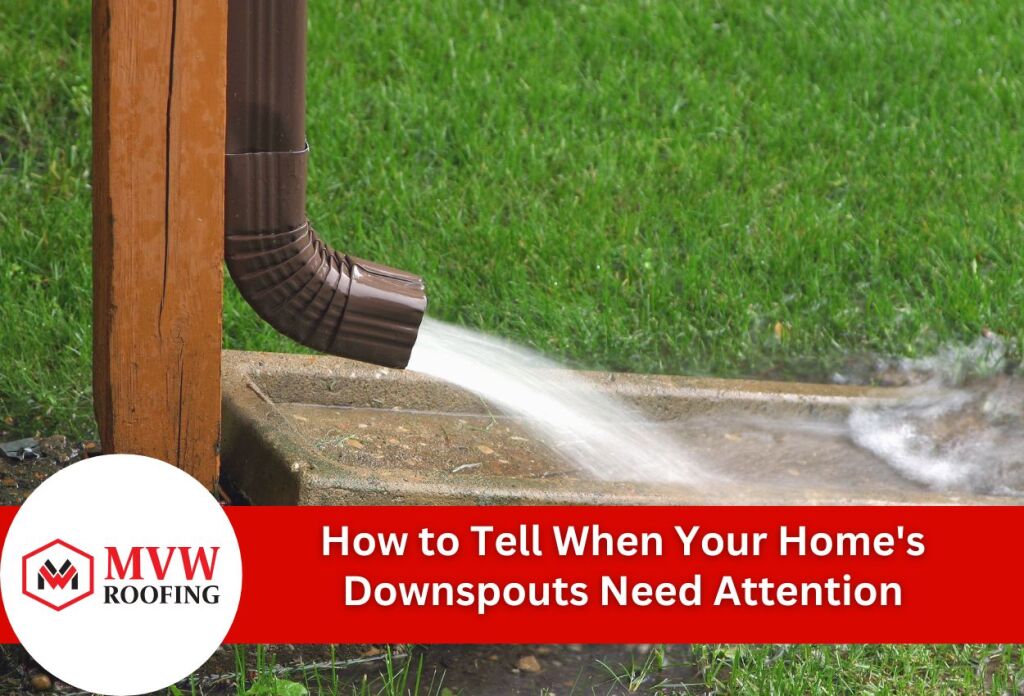
When downspouts fail or become damaged, the consequences can be extensive. Recognizing the signs of damaged downspouts early can save homeowners thousands of dollars in potential repairs to their property’s foundation, basement, and exterior.
Common gutter downspout problems include clogs, cracks, loose connections, and improper water flow patterns. Clogged downspouts often result from debris accumulation, while physical damage can occur from weather, age, or impact from falling branches.
Understanding when downspout repair or replacement is necessary helps maintain the integrity of the entire drainage system. Downspout water damage typically manifests gradually, making early detection crucial for preventing extensive property damage. Regularly inspecting and maintaining downspouts ensures water is drained away from the home and protects one of the most significant investments most people make in their lifetime.
#1. Visible Cracks and Holes That Signal Trouble
Physical damage to downspouts creates obvious entry points for water to escape before reaching its intended destination. Split seams are one of the most common signs of damaged downspouts, typically developing where sections connect or at elbow joints. These separations allow water to leak directly onto foundations, walkways, and landscaping instead of flowing safely away from the structure.
Rust holes frequently appear on older metal downspouts, starting as small pinprick openings that gradually expand over time. Even tiny perforations can release significant amounts of water during heavy rainfall, creating streaks down exterior walls and pooling near the foundation. These rust spots indicate the downspout material has deteriorated beyond simple maintenance solutions.
Other causes of damage include falling branches, hail, or lawn equipment that creates dents and cracks that compromise the downspout’s structural integrity. What begins as a minor crack can rapidly worsen during Georgia’s intense thunderstorms and seasonal heavy rains. The repeated freeze-thaw cycles common in the region cause existing cracks to expand, accelerating the deterioration process.
While mall openings may seem insignificant, they allow water to escape continuously during extended rainy periods. This persistent moisture exposure leads to water damage affecting nearby structures and creates ideal conditions for mold growth. When multiple cracks or holes are present, damaged downspout replacement is often more affordable than attempting repairs on severely compromised components.
#2. Water Stains and Puddles Around Your Foundation
Water stains on exterior walls and siding provide clear evidence that downspouts are failing to direct water away from the home. These discolored streaks typically appear as dark vertical lines running down from gutters or horizontal bands along the foundation where water has repeatedly splashed against surfaces. The staining occurs when downspouts leak, overflow, or discharge water too close to the structure instead of carrying it to the appropriate drainage areas.
Pooling water near the foundation is a serious consequence of gutter downspout problems. When downspouts become clogged or damaged, water accumulates around the base of the home rather than flowing toward street drains or designated runoff areas. This standing water can seep into basements, compromise foundation stability, and create expensive structural issues over time.
White chalky deposits called efflorescence often accompany water stains on brick or concrete surfaces, indicating moisture has seeped into the masonry. These mineral deposits appear when water evaporates and leaves behind dissolved salts from the building materials. The presence of efflorescence confirms ongoing moisture problems requiring immediate attention.
Landscaping damage around downspout discharge points also signals drainage issues. Eroded soil, dying plants, or excessively wet areas near the foundation indicate water is not being properly channeled away from the home. Addressing these drainage problems promptly through downspout repair or system adjustments prevents more extensive water damage to both the structure and the surrounding property.
#3. Sagging and Pulling Away From the House
Downspouts that sag or separate from their mounting brackets create serious gaps in the home’s water management system. This physical detachment occurs when brackets loosen over time due to the weight of water, debris, or thermal expansion and contraction. Sagging sections disrupt water flow and allow moisture to escape at connection points rather than reaching ground-level discharge areas.
Loose mounting hardware becomes evident when downspouts pull away from exterior walls or appear to hang at odd angles. The brackets securing downspouts to siding or masonry can work loose from repeated stress during heavy rainfall or high winds. When these connections fail, the entire downspout system loses its structural support and cannot effectively channel water away from the foundation.
Additionally, bent or twisted downspout sections indicate the system has endured significant stress beyond its design capacity. This damage typically results from extreme weather conditions or physical impact from falling debris. Clogged downspouts often contribute to sagging problems by creating excessive weight and pressure within the system, causing brackets to fail under the additional load.
Proper attachment ensures downspouts maintain their intended slope and alignment for optimal water flow. When sections separate from mounting points, water can back up into gutters or spill directly onto foundations and walkways. Reattaching or reinforcing loose or sagging downspouts prevents minor attachment issues from worsening.
#4. Clogs That Prevent Proper Water Flow
Debris accumulation is the primary cause of downspout clogs that prevent effective water drainage. Leaves, twigs, and organic matter naturally collect in gutters before washing into downspouts during rainfall. These materials can create dense plugs, particularly at elbow joints and connection points where the diameter narrows. Seasonal leaf fall creates especially challenging conditions, as wet leaves compact together and form impenetrable barriers within the downspout channel.
Small animals and birds occasionally build nests inside downspouts, creating unexpected obstructions that completely halt water flow. These blockages typically develop during dry periods when animals seek sheltered spaces for nesting. Rodent nests, bird debris, and even deceased animals can lodge within downspout sections, preventing normal water movement during subsequent rainfall events. Other than organic debris, tennis balls, toys, and other objects sometimes enter gutter systems and travel down into downspouts, where they become wedged in narrow sections.
Recognizing clogged downspouts requires looking for specific warning signals during rainfall. Water overflowing from gutters instead of flowing through downspouts indicates clogs. Unusual gurgling sounds from the drainage system suggest water is struggling to pass through restricted openings. When these signs appear, prompt attention prevents the development of more serious gutter downspout problems that could require extensive repair work.
#5. Peeling Paint and Rust
Surface deterioration on downspouts begins with minor paint chips and gradually progresses to extensive rust that compromises the entire system. Constant exposure to moisture, temperature fluctuations, and UV radiation breaks down protective coatings over time. Once the underlying metal becomes exposed, oxidation accelerates rapidly, creating weak spots that eventually develop into holes and structural failures.
Peeling paint typically appears first at joints, seams, and mounting bracket locations where water tends to accumulate and remain in contact with the surface longer. These vulnerable areas experience the most stress during thermal expansion and contraction cycles, causing protective finishes to crack and separate from the metal substrate. Small paint defects provide entry points for moisture to reach the underlying material and begin the corrosion process.
Initially, rust spots appear as small orange or brown discolorations on the downspout surface but quickly spread outward from the original location. The oxidation process weakens the metal and creates rough, pitted surfaces that trap additional moisture and debris. Advanced rust formation eventually creates holes that allow water to escape, leading to the same foundation and structural problems associated with other types of physical damage.
Addressing surface deterioration early through cleaning, priming, and repainting can extend the downspout’s life significantly. However, extensive rust damage often indicates that replacement will provide better long-term value than attempting to repair severely corroded components that will likely fail again.
When to Call a Professional for Help with Damaged Downspouts
Distinguishing between manageable maintenance tasks and situations requiring professional expertise helps homeowners avoid expensive mistakes while addressing downspout issues effectively. Simple cleaning of accessible downspout sections and clearing minor debris from ground-level areas typically fall within most homeowners’ capabilities. However, problems involving structural damage, complex repairs, or safety concerns warrant intervention from a professional contractor.
Height-related work presents significant safety risks that many homeowners underestimate. Accessing upper-level downspout connections, evaluating gutter attachments, and performing repairs near rooflines require proper equipment and experience. Professional contractors possess specialized ladders, safety gear, and training necessary to work safely at elevated heights while thoroughly assessing the entire drainage system.
Plus, extensive downspout damage often indicates underlying problems that extend beyond obvious symptoms. A professional evaluation can identify hidden structural issues, improper installation methods, or drainage design flaws that contribute to recurring problems. Experienced contractors recognize patterns that suggest foundation concerns, siding damage, or roof-related issues that require coordinated repair approaches.
A professional assessment is even more valuable when multiple signs of damage appear simultaneously or when previous repair attempts have failed. Qualified contractors can determine whether downspout repair addresses the root cause or if replacement will provide better long-term solutions.
Protect Your Home with Expert Downspout Services from MVW Roofing
If you’ve noticed any signs of damage to your downspouts, such as cracks, holes, or rust, it’s crucial not to ignore them. Damaged downspouts can lead to serious water damage and foundation issues for your Southwest Georgia home, especially during heavy rain. MVW Roofing specializes in diagnosing and repairing downspout problems to ensure your home stays protected from water-related damage.
Contact MVW Roofing today at (229) 821-3150 for a professional assessment. Our expert team is ready to provide you with efficient downspout repair, replacement, and maintenance services. Ensure your downspouts are functioning correctly and safeguard your home with the help of MVW Roofing.
